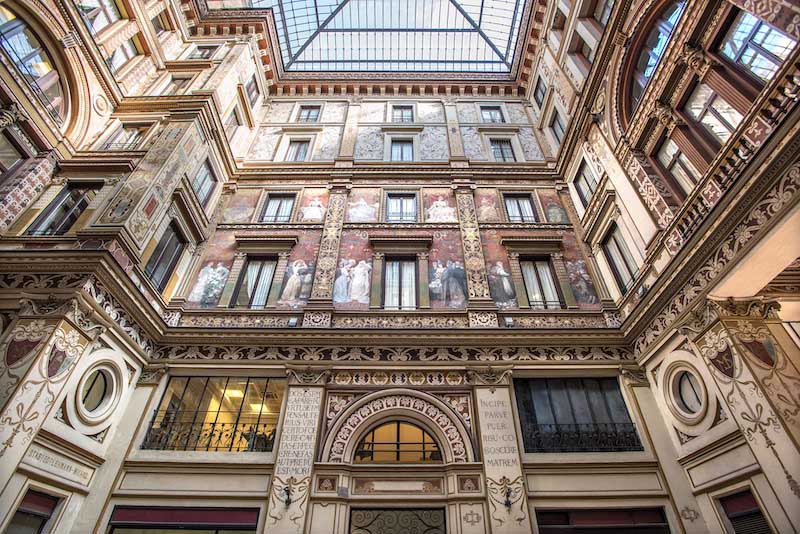A stone’s throw from Via del Corso and the Trevi Fountain, in the midst of the hustle and bustle of the capital’s centre that thousands of tourists and Romans pass through every day, lies the jewel of Art Nouveau Rome: the Galleria Sciarra. Anyone passing by chance in the alleys of the Trevi district, more precisely in Via Minghetti, cannot fail to be enraptured by the spectacle of this covered walkway that was once a single complex with Palazzo Sciarra Colonna di Carbognano. The Galleria Sciarra, not to be confused with the nearby and decidedly more crowded Galleria Sordi, is an architectural masterpiece that springs up almost suddenly in the midst of the classicism of the Eternal City.
Discover Galleria Sciarra with us with one of your Rome Private Tours.
How to visit Galleria Sciarra
It is known as Galleria Sciarra, as it is a covered walkway – a private courtyard but open to the public during office hours – the entrances are at Via Marco Minghetti and Piazza dell’Oratorio, the Galleria is very close to the Trevi Fountain, yet it is a little-visited place known only to discerning tourists and locals.
Galleria Sciarra is one of the few examples of Art Nouveau architecture in Rome. The Galleria is part of a prestigious architectural complex that starts at the Banco di Roma and ends at the Teatro Quirino on Via delle Vergini, occupying the centre as a true Art Nouveau heart of the complex.
The Gallery is an extension of an older aristocratic palace, built between the late 16th and early 17th century, which from that time on was one of the richest and most imposing buildings in the city, with attention to every architectural detail. The gateway, for example, has been described as one of the most beautiful gates in Rome, so much so that it has been included in the Four Wonders of the Eternal City.
The history of Galleria Sciarra
The building as we know it today was built between 1885 and 1888 as the courtyard of the Sciarra Colonna di Carbognano palace, during the renovation and modernisation of Rome’s central districts. Various renovations and constructions of bourgeois palaces can be placed in this historical period, because with the passage of the capital of Italy from Florence to Rome, a profitable period of transformation began for the eternal city, which with its new role needed to create new prestigious spaces for a bureaucratic apparatus up to the mark.
New commercial activities flourished in Rome, the population continued to grow and with it the need for new living spaces. The cultural ferment of the time can be seen in the richness of the decorations and the magnificence of the Gallery, which shows the capital’s new prestige.
The gallery, commissioned by Prince Maffeo Barberini-Colonna di Sciarra, had the function of connecting the spaces he owned. The nobleman in fact, besides being engaged in political activity as a deputy of the Kingdom of Italy, was also an entrepreneur in the publishing industry. In addition to his residence, Galleria Sciarra also housed the editorial office of the daily newspaper La Tribuna, and later also the editorial office of the famous literary magazine that had Gabriele D’Annunzio as its editor, the Cronaca Bizantina.


